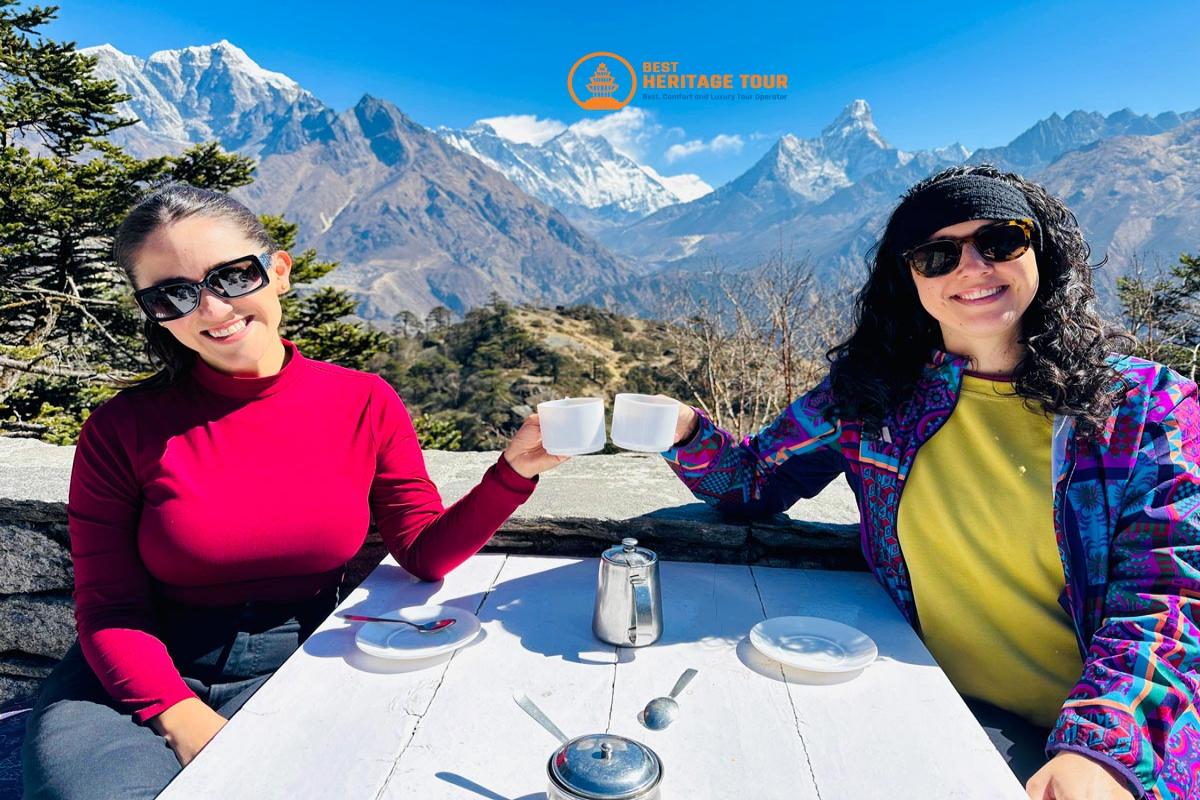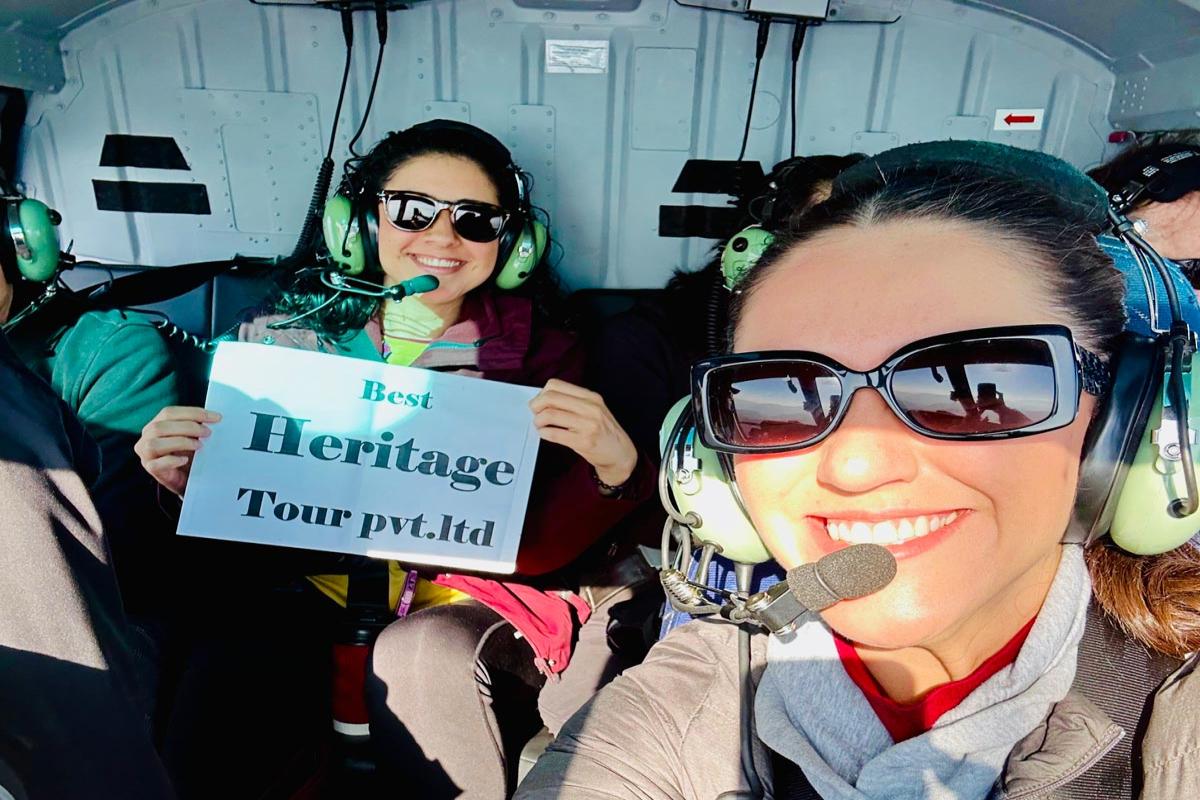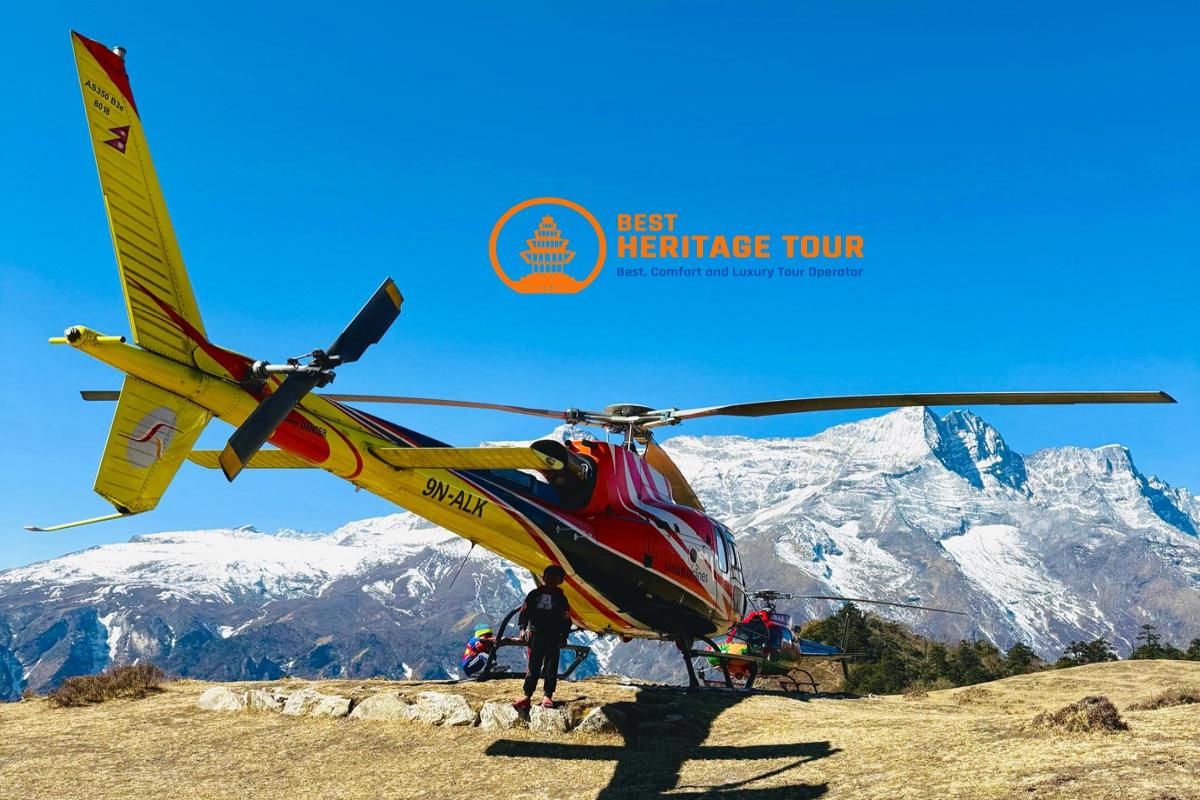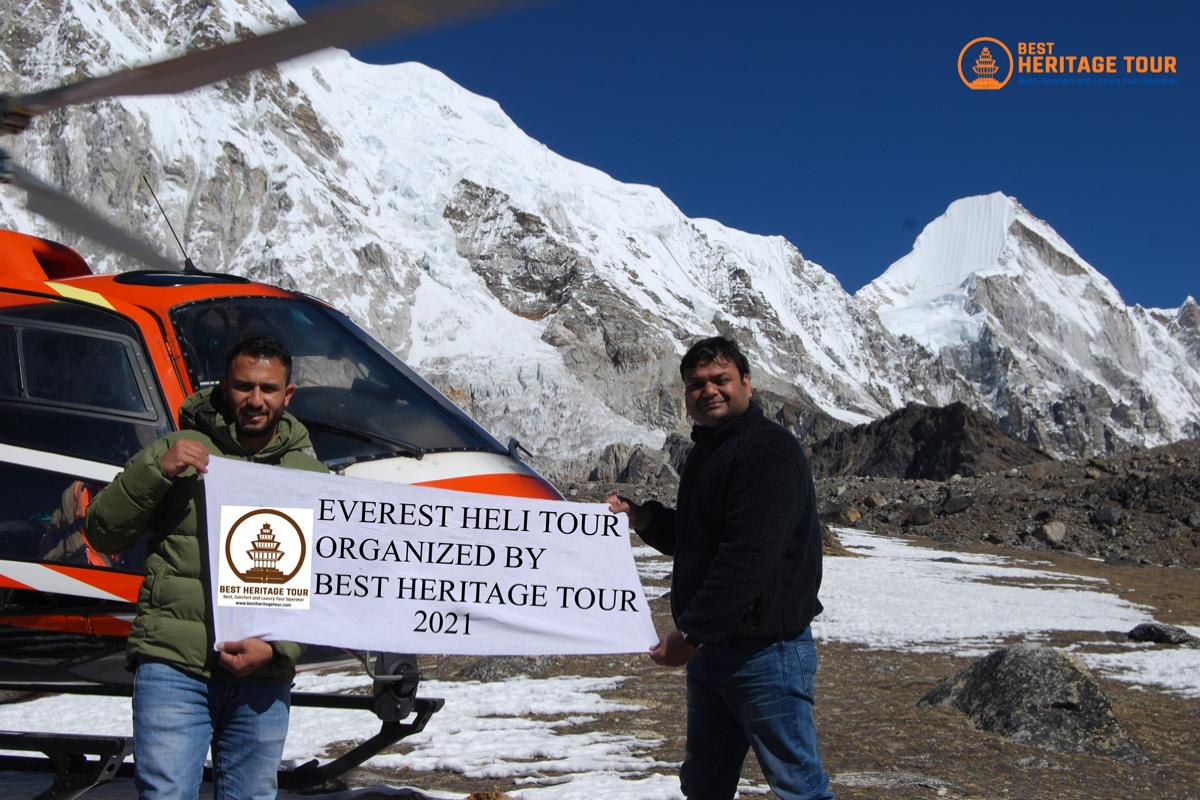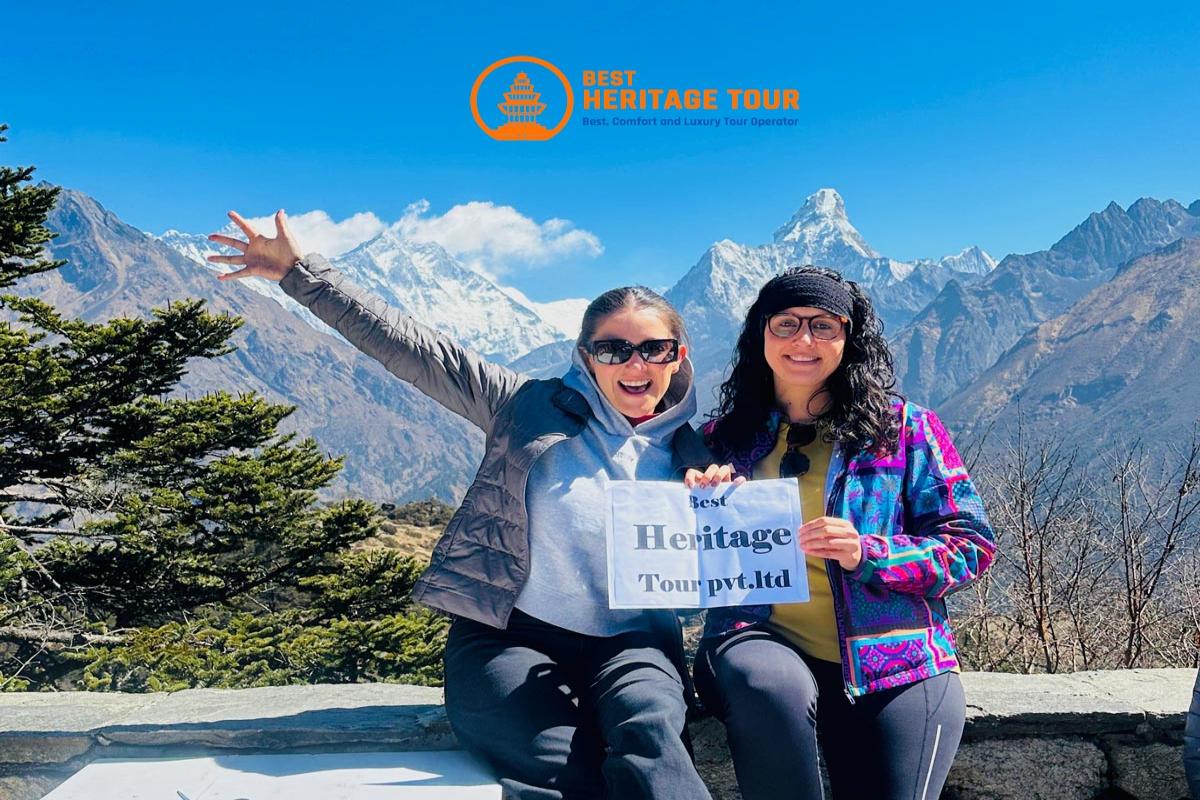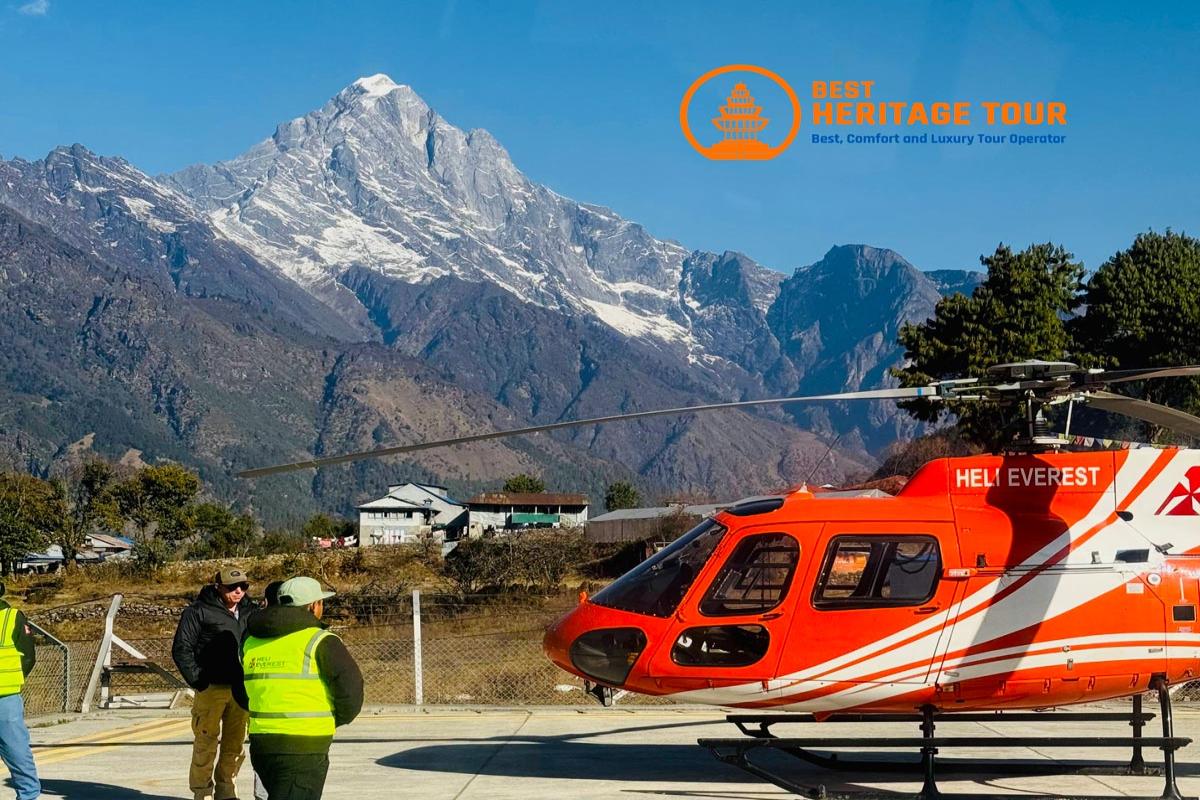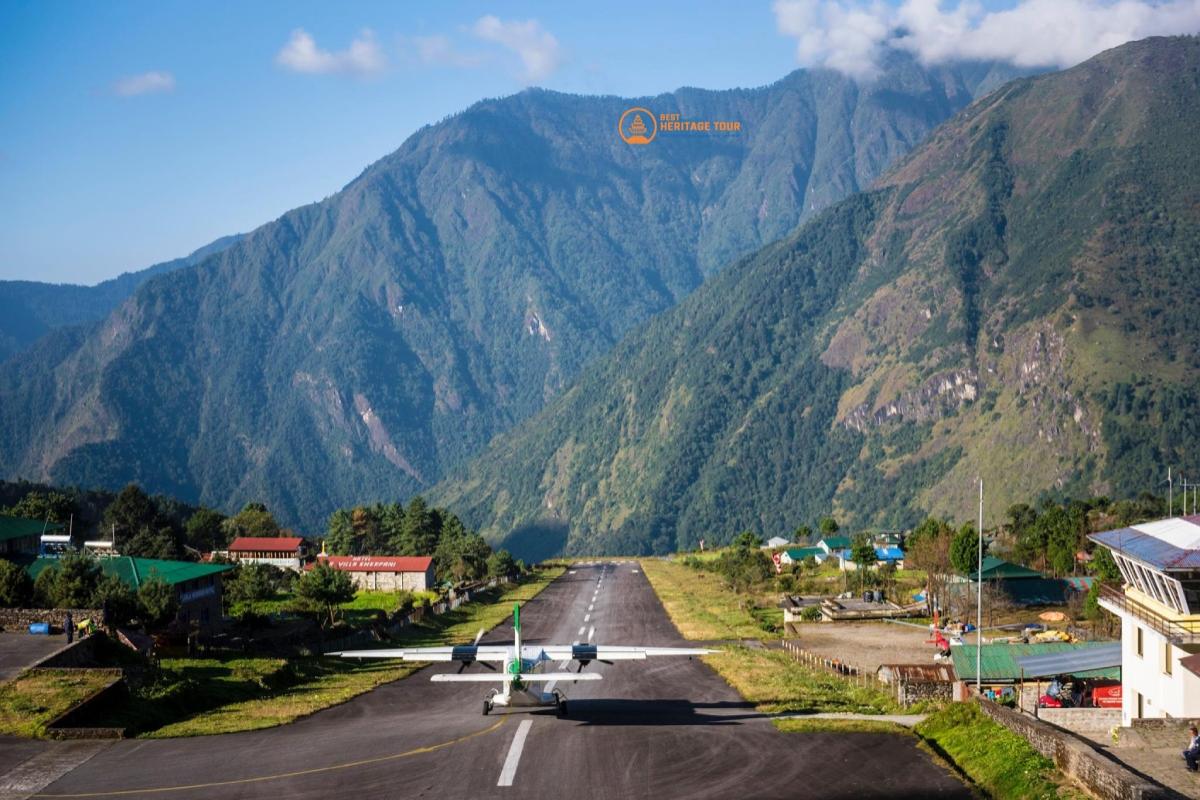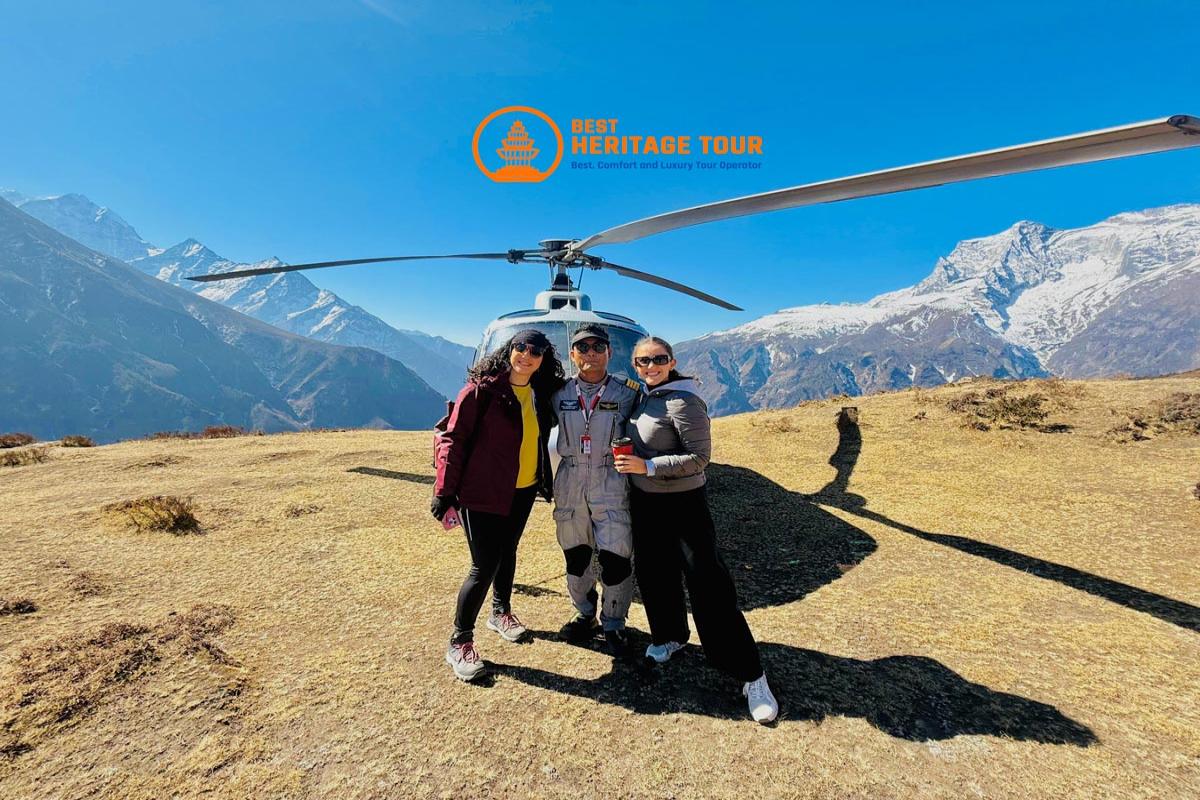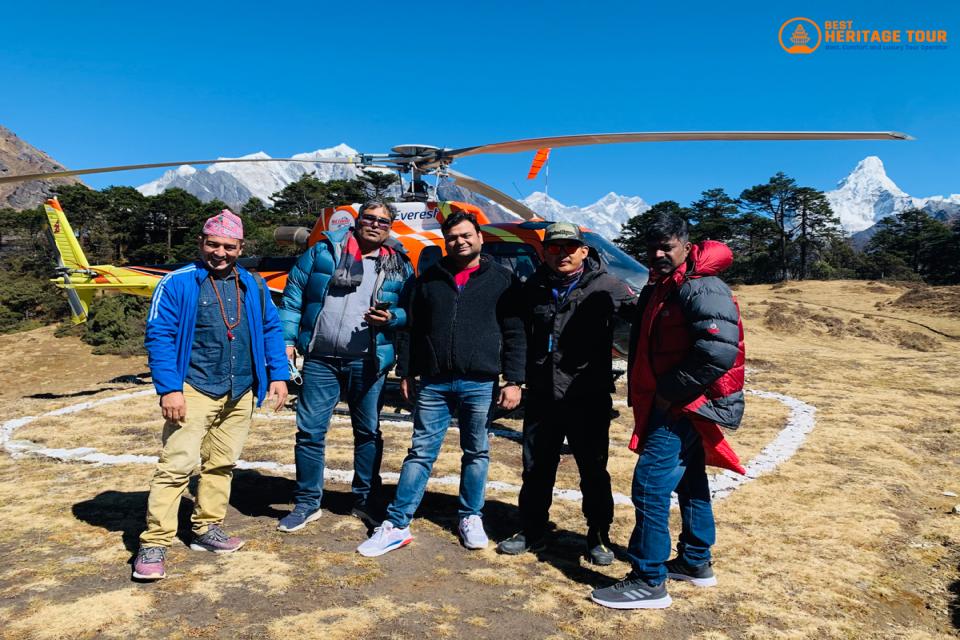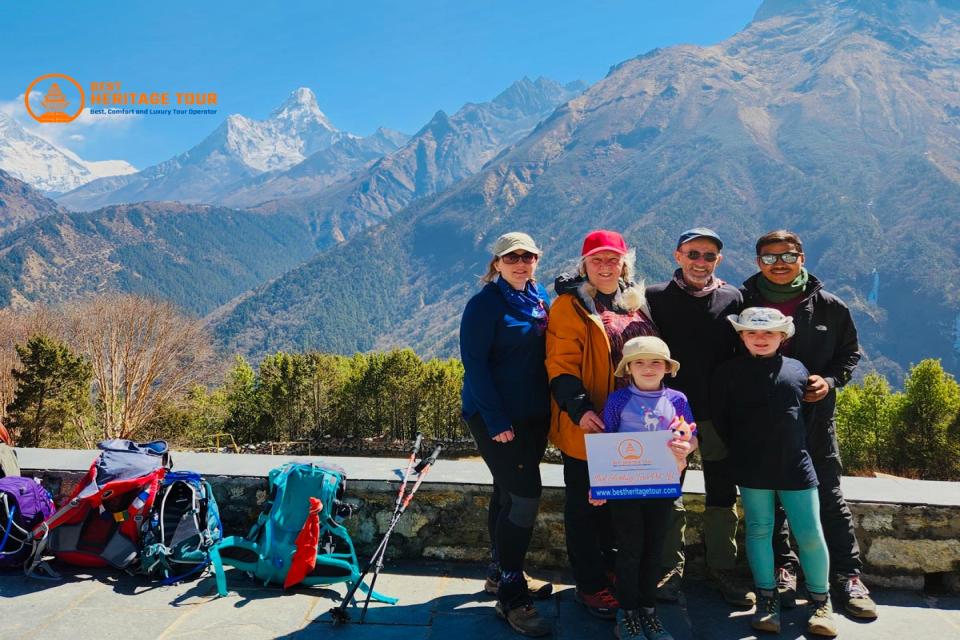Everest Base Camp Trek with Helicopter Return- 3 Days
Insight on EBC Trek with Helicopter Return
The Everest Base Camp Trek with Helicopter Return offers an exhilarating blend of adventure and luxury. Over three days, trek through vibrant Sherpa villages and ancient monasteries, immersing yourself in the rich Himalayan culture. The journey culminates with a thrilling helicopter flight over Everest Base Camp, Kala Patthar, and the Khumbu Glacier, providing unparalleled aerial views of the world's highest peaks. This expedition is perfect for those seeking an unforgettable Himalayan experience within a limited timeframe.
Trip at a Glance
Key Highlights
- Scenic flight to Lukla with stunning Himalayan views.
- Trek through Sherpa villages and terraced landscapes.
- Visit Buddhist monasteries along the trail.
- Cross the iconic Hillary Suspension Bridge.
- Explore Namche Bazaar and the National Park Museum.
- Hike to Everest View Hotel for panoramic mountain vistas.
- Helicopter flight to Everest Base Camp, Kala Patthar, and Khumbu Glacier.
Benefits of booking EBC Short Trek with Helicopter Return with Best Heritage Tours
- Free private airport transfers on arrival and departure.
- Personalized online trip discussion after booking.
- Experienced guides ensuring safety, local insights, and smooth trekking.
- Easy booking and payment system with multiple options.
- 24/7 phone support via WhatsApp, Viber, Skype, and direct calls (+977-9851149197 / +977-9810043046).
- Permit arrangements handled by the company for hassle-free trekking.
- Comfortable accommodations and support throughout the trek.
Trip Overview
The Everest Base Camp Trek with Helicopter Return is a short, premium adventure that allows trekkers to experience the grandeur of the Himalayas without the challenges of a long expedition. Beginning with a scenic flight to Lukla, that offers breathtaking aerial views of towering peaks and deep Himalayan valleys, immediately immersing travelers in the magic of the region.
From Lukla, trekkers embark on a gentle hike to Phakding, passing charming Sherpa villages, terraced fields, and rhododendron forests. The trail provides an authentic glimpse into Sherpa life, with opportunities to visit Buddhist monasteries, interact with locals, and witness traditional customs.
The journey continues to Namche Bazaar, the bustling cultural hub of the Everest region. Here, trekkers can explore vibrant markets, cozy cafes, and the National Park Museum, which showcases the natural and cultural heritage of Sagarmatha National Park. Short hiking days and well-paced itineraries allow ample time to soak in the scenery, take photographs, and enjoy local experiences.
A highlight of the trek is a visit to the Everest View Hotel (3,880 m), offering spectacular panoramic vistas of Mount Everest, Ama Dablam, Lhotse, and surrounding peaks. The adventure reaches its pinnacle with a helicopter flight to Everest Base Camp, Kala Patthar, and the Khumbu Glacier, providing a once-in-a-lifetime aerial perspective of the Himalayas and the iconic Khumbu Icefall.
The trek concludes with a scenic helicopter ride back to Kathmandu, giving travelers one final unforgettable view of the towering Himalayan landscape. Perfect for those with limited time or seeking a luxurious experience, this trek combines breathtaking mountain scenery, cultural encounters, and the thrill of a helicopter adventure, making it an ideal choice for families, first-time trekkers, or anyone wishing to witness Everest in a short yet unforgettable journey.
What to Expect on the Everest Base Camp Trek with Helicopter Return
1. A Scenic Flight to Lukla
Your adventure begins with a thrilling mountain flight to Lukla (2,860 m) - one of the most scenic and exciting air routes in the world. As you soar above lush valleys and rugged ridgelines, you’ll be greeted with your first glimpse of the mighty Himalayas, including Everest itself.
2. Easy and Rewarding Trekking Days
This trek offers a short yet immersive Himalayan experience, ideal for beginners and those with limited time. You’ll hike through Sherpa villages, pine forests, and suspension bridges, taking in the peaceful rhythm of mountain life. The trails are moderate, with plenty of opportunities to rest, take photos, and enjoy the scenery.
3. Explore Sherpa Culture in Namche Bazaar
At Namche Bazaar, the lively heart of the Everest region, you’ll experience Sherpa hospitality and culture firsthand. Wander through local markets, visit ancient monasteries, and interact with locals who have lived in harmony with the mountains for generations.
4. Unforgettable Views from Everest View Hotel
A short hike from Namche leads to the Everest View Hotel (3,880 m) - one of the world’s highest luxury hotels. From here, you’ll be rewarded with breathtaking panoramic views of Mount Everest, Ama Dablam, Lhotse, and other peaks, making it a perfect spot for photos and relaxation.
5. Helicopter Flight to Everest Base Camp & Return to Kathmandu
The grand finale of your journey is a scenic helicopter flight over Everest Base Camp, Kala Patthar, and Khumbu Glacier. Experience the thrill of seeing the world’s highest peak up close before flying back to Kathmandu, ending your adventure in absolute style and comfort.
Alternative Routes
Day 1: Flight from Kathmandu/Manthali to Lukla & Trek to Phakding
Day 2: Trek from Phakding to Namche Bazaar
Day 3: Rest and Acclimatization Day in Namche Bazaar
Day 4: Trek from Namche to Tengboche
Day 5: Trek from Tengboche to Dingboche
Day 6: Rest and Acclimatization Day in Dingboche
Day 7: Trek from Dingboche to Lobuche
Day 8: Trek from Lobuche to EBC and return to Gorak Shep
Day 9: Trek from Gorak Shep to Kala Patthar viewpoint, return back to Gorak Shep & continue the trek to Pheriche
Day 10: Helicopter Ride from Pheriche to Lukla & then Flight from Lukla to Kathmandu/Manthali
Note: A customized return helicopter ride is available from Tengboche, Dingboche, or Lobuche to Lukla or directly to Kathmandu upon request.
Itinerary
The trek starts with a majestic flight to Lukla (2,840 m above sea level) and continues to Phakding after a snack break in Lukla. The walk continues with some ascents and descents through villages and farmland. After some river crossings, the trail crosses the river and enters Phakding.
The hike starts after breakfast and continues hiking to Monjo for permit check, then climbing to reach Jhorsar and then Hillary Suspension Bridge. Further climbing will bring you to the hill point (Top Dada) from where you can get a glimpse of Everest. After that, the trek continues uphill all the way to Namche Bazaar. Afternoon stroll around Namche Bazaar and visit a monastery.
Today is going to be one of the most awaited days. Hike to National Park Museum, visit Everest View Hotel (3,880 m) and explore the mesmerizing Himalayan ranges while having tea/coffee.
Finally, fly to Pheriche (4,371 m) by helicopter and spend unforgettable time exploring the Himalayan ranges. After that, helicopter flight continues to Everest Base Camp, Kala Patthar, Khumbu Glacier and finally return to Kathmandu via Lukla or descend to Namche Bazaar on the same day.
What is included?
- Flight Cost from Kathmandu to Lukla
- Private transportation from your hotel to the airport and drop off
- Accommodation in a Hotel or Teahouse
- Meals including Breakfast, Lunch & Dinner throughout the trek
- All necessary permits fees: Sagarmatha National Park Permits, Khumbu Pasang Lhamu Rural Municipality Permit
- An experienced English speaking government-registered trekkking guide
- Helicopter Ride Cost to Everest Base Camp, Kala Patthar & Kathmandu
- Souvenir - Best Heritage Tour T-shirt & Purse
What is not included?
- International flight airfare
- Visa fee for Nepal
- Personal expenses such as: Wireless internet access, hot water showers, battery recharging facilities, and individual expenditures
- Accommodation & Meals in Kathmandu
- Travel insurance
- Tips for guides and porters (recommended)
- Additional costs resulting from factors beyond our control, such as landslides, weather conditions, itinerary adjustments due to safety concerns, illness, changes in government policies, strikes, etc
- Anythings that are not mentioned in Itinerary or Included section
- All government taxes 13%, SSF, and 10% service charges
Route Map
Equipment
Clothing
-
Base Layers: Moisture-wicking thermal tops and bottoms.
-
Insulating Layer: Fleece or down jacket for warmth.
-
Outer Layer: Waterproof and windproof jacket and pants.
-
Trekking Pants and Shirts: Lightweight, breathable, and quick-drying.
-
Warm Hat and Gloves: Essential for cold mornings and evenings.
-
Sun Hat / Cap and Sunglasses: Protection against UV rays at high altitude.
-
Hiking Socks: Wool or synthetic, multiple pairs recommended.
-
Trekking Boots: Sturdy, waterproof, and well-broken-in for comfort on trails.
Essential Trekking Gear
-
Backpack (30-40L)
-
Trekking Poles
-
Water Bottle / Hydration System
Accessories
-
Headlamp / Flashlight
-
Sunscreen and Lip Balm
-
Personal Toiletries (Toothbrush, toothpaste, wet wipes, hand sanitizer, Towel, etc.)
-
Camera / Smartphone
-
Snacks / Energy Bars
-
Power Bank / Extra Batteries
Trip Info
Best Time for the Everest Base Camp Trek with Helicopter Return
The Everest Base Camp Trek with Helicopter Return can be done throughout the year, offering flexibility for travelers with tight schedules. However, the best seasons to enjoy clear skies, pleasant temperatures, and the finest mountain views are spring (March to May) and autumn (September to November). During these months, the weather is stable, visibility is excellent, and the landscapes are at their most vibrant - perfect for photography and sightseeing.
Winter (December to February) is also a good time for those who prefer fewer crowds and crisp mountain air. Though mornings and evenings can be cold, the skies are generally clear, providing stunning visibility of the Himalayas.
The monsoon season (June to August) is the least ideal time due to occasional rain and cloud cover that can affect flights to Lukla and reduce mountain visibility. However, the trails remain lush and peaceful, and those who don’t mind some rain can still enjoy a rewarding trek with fewer tourists.
Permits Required for Everest Base Camp Trek with Helicopter Return
For Everest Base Camp Trek with Helicopter Return, two permits are required for safety, conservation, and support of local communities. Best Heritage Tour arranges all permits for a smooth, hassle-free experience.
-
Sagarmatha National Park Permit: Required for trekking in the Khumbu region, including Everest View and surrounding trails. It helps protect wildlife, forests, and cultural heritage.
-
Khumbu Pasang Lhamu Rural Municipality (KPLRM) Permit: Mandatory for trekking through villages and trails under KPLRM, supporting local development and trail maintenance.
Trekkers need to provide a scanned copy of a valid passport (minimum six months’ validity) and two passport-sized photos. Best Heritage Tour will handle the applications and provide the permits before the trek. Carry them along, as authorities may check at checkpoints.
Accommodation & Meals
During the Everest Base Camp Trek with Helicopter Return, accommodation is provided in a mix of comfortable hotels and cozy teahouses. In Phakding and Namche Bazaar, you’ll stay in a comfortable teahouses offering a warm and authentic Himalayan experience. These teahouses are simple but comfortable, featuring clean rooms, shared facilities, and friendly Sherpa hospitality that makes your stay memorable.
Meals during the trek include breakfast, lunch, and dinner, served fresh and hearty to keep you energized throughout your journey. Most teahouses offer a variety of traditional Nepali dishes such as dal bhat (rice and lentil soup), noodles, soups, and momos (dumplings). For those who want to try something different, there are plenty of other options, including continental and Tibetan-style meals, available at an additional cost.
Hot beverages like tea and coffee are typically included with breakfast, while other drinks and snacks can be purchased directly at the teahouses. Whether you prefer to enjoy local flavors or sample other cuisines, the Everest region offers a surprisingly wide range of choices to suit your taste and comfort.
Physical Fitness
The Everest Base Camp Trek with Helicopter Return is a short and easy adventure, suitable for travelers of all ages and fitness levels. It’s designed for those who want to experience the beauty of the Everest region without the demanding climbs or long trekking days of traditional high-altitude routes.
The trek involves moderate walking on well-marked trails, with plenty of rest stops and gradual altitude gain, allowing your body to adjust comfortably. No prior trekking experience is required - a basic level of fitness and a love for nature are enough to fully enjoy this journey. Light exercise, walking, or short hikes before the trip can help improve stamina and make the trek even more enjoyable. With proper pacing, professional guidance, and comfortable accommodations along the way, this trip is perfect for families, beginners, and anyone seeking a relaxed yet immersive Himalayan experience.
Health & Safety
At Best Heritage Tour, your safety and well-being are our top priorities. The Everest Base Camp Trek with Helicopter Return is a relatively short and low-risk journey, but our experienced guides are always attentive to your health and comfort. They are trained in first aid and altitude awareness, ensuring any signs of fatigue or discomfort are quickly addressed. A basic medical kit is carried during the trek, and your blood oxygen levels can be monitored regularly in higher areas like Namche Bazaar.
Although the risk of altitude sickness is minimal on this itinerary, it’s important to walk at a steady pace, stay hydrated, and rest well. Our team provides guidance throughout, and in the unlikely event of any emergency, quick evacuation by helicopter can be arranged. With professional supervision, careful planning, and personalized care, you can enjoy your Everest adventure with complete peace of mind.
Travel Insurance
Travel insurance is recommended for the Everest Base Camp Trek with Helicopter Return to ensure peace of mind throughout your journey. Even though the trek is relatively easy and at moderate altitude, insurance should cover medical emergencies, high-altitude trekking, and evacuation in case of unexpected situations. Best Heritage Tour advises trekkers to have a policy that protects against unforeseen events so you can fully enjoy the trek, the breathtaking mountain scenery, and Sherpa cultural experiences without worry.
Visa for Nepal
All travelers (except Indian citizens) must obtain a Nepal tourist visa to join the Everest Base Camp Trek with Helicopter Return. Visas are easily available upon arrival at Tribhuvan International Airport in Kathmandu or at designated land border points. The process is quick and simple - fill out the form, provide a passport-sized photo, and pay the applicable fee for a 15, 30, or 90-day visa. Make sure your passport is valid for at least six months from your arrival date. To save time, you can also apply online through the official Nepal Immigration website before your trip.
Booking & Payments
To confirm your booking, a 10% deposit of the total trip cost is required at the time of reservation. The remaining balance is payable upon arrival in Nepal before the trek begins. Payments can be made via bank transfer, credit card, or cash, though additional bank or card charges may apply. Full details of our cancellation and refund policy are shared before booking, and group discounts are available for larger parties. Private and customized departures can also be arranged to match your schedule and preferences.
Last-Minute Booking
If you decide to embark on this adventure on short notice, Best Heritage Tour also accepts last-minute bookings. For these, full payment (100%) must be made at least 24 hours before departure. While we strive to accommodate every request, last-minute bookings depend on flight availability to Lukla and accommodation space in Namche Bazaar. For assistance, contact us directly at +977-9851149197 / +977-9810043046 or email info@bestheritagetour.com / bestheritagetour@gmail.com.
Trip Extension
If you wish to extend your Himalayan adventure, Best Heritage Tour offers many exciting add-ons. You can expand your experience with Everest View, Gokyo Valley, or the classic Everest Base Camp trek, or enjoy cultural tours in Kathmandu Valley, wildlife safaris in Chitwan, or relaxing stays in Pokhara. Our team can help you design a personalized itinerary that fits your time, budget, and interests - ensuring your Nepal trip continues with the same comfort, adventure, and care that defines every journey with us.
Review
Amazing views of Everest from Helicopter
Must say one of the best helicopter ride I had ever taken in my life. The views of EBC and Kala Patthar from the sky was just felt like out of the world. Watching the Everest peak...
View DetailAmazing aerial views of Mountains
What a wonderful helicopter ride to Everest Base Camp. The one week long trekking journey to EBC was just completed in 30 minutes. The views of mountains from EBC was very...
View DetailReached EBC with little trekking
This tour is perfect for someone like me who wants to reach EBC in short time with a feel of trekking. The trek portion was amazing. I crossed many small rivers and streams....
View Detailvery comfortable and easy tour to EBC
Very comfortable and amazing tour. Reached Everest Base Camp Kalapathar by helicopter with a little trekking. Got the chance to feel the Himalayas land, cold waters from the...
View DetailFAQ's
Yes, most visitors need a tourist visa to enter Nepal. A visa can be obtained on arrival at Tribhuvan International Airport in Kathmandu or applied for in advance at a Nepalese embassy or consulate.
Yes, you will need two passport-sized photos for both the visa application and the trekking permits, so it's a good idea to bring extra copies just in case.
You'll need a valid passport (with at least six months validity), a passport-sized photo, and the visa fee (which varies depending on the duration of stay).
Yes, it’s possible to extend your visa if you wish to stay longer in Nepal. Extensions can be processed at the Department of Immigration in Kathmandu or Pokhara, but you should apply before your current visa expires.
You can exchange US dollars or Euros for Nepalese rupees upon arrival, but we recommend carrying cash in the local currency for most transactions outside of major cities.
Physical preparation is essential to a successful trekking experience. Begin an exercise program 6-8 weeks before your hike that focuses on:
- Aerobic exercise: Activities such as running, cycling, and swimming to improve endurance.
- Strength training: Leg, core, and upper body exercises to increase strength.
- Practice hiking: Fill up your backpack and go on a short hike to simulate trekking conditions.
Yes, Nepal offers an electronic visa (e-visa) that can be applied for online before arriving. This process enables you to bypass the visa queue upon arrival at the airport. After completing the online application, you can get your visa stamped on arrival.
Yes, if you wish to extend your stay, you can apply for a visa extension at the immigration office in Kathmandu or Pokhara.
While Nepali is the primary language, most staff members in lodges speak English, and some may even speak other languages. Communication should not be an issue for international tourists.
It’s advisable to be up-to-date on routine vaccinations, including hepatitis A and typhoid. Talk to your doctor about the vaccinations you need for Nepal.
While basic medical services can be found in larger villages such as Namche Bazaar, serious health concerns may require helicopter evacuation.
The Namche Trek is a short trek in the Khumbu region of Nepal, taking you to Namche Bazaar, the gateway to Everest. This luxury trek includes a helicopter return from Everest Base Camp, allowing you to experience breathtaking views without the strenuous return trek.
The trek lasts three days, including one day for acclimatization and exploration in Namche Bazaar, and a helicopter return on the last day.
The helicopter return allows trekkers to fly from Everest Base Camp or nearby locations back to Kathmandu or Lukla. The flight offers stunning aerial views and is a quicker alternative to trekking back.
Choosing the best heritage tour provides an enriching cultural experience, blending education, comfort, and unique local interactions for unforgettable travel memories.
The trek offers opportunities to experience Sherpa culture, including visits to local monasteries, traditional villages, and markets in Namche Bazaar.
Yes, options such as mountain biking, rock climbing, and cultural tours are available in addition to trekking.
While it is possible to trek independently, it is highly recommended to hire a licensed guide for navigation, cultural insights, and safety in remote areas.
Yes, all our guides are fluent in English and many speak other languages. This facilitates clear communication and enhances your overall experience.
Luxury accommodations offer enhanced services, larger rooms, better amenities, and more personalized care compared to standard lodges.
The best months to trek are September to November and March to May when the weather is mild and clear.
Temperatures can vary significantly. In September and October, daytime temperatures in Namche can range from 15°C to 20°C (59°F to 68°F), while nighttime can drop to 5°C (41°F) or lower. In March and April, expect similar daytime temperatures, but nights can be colder.
Weather conditions in the Himalayas can change rapidly. Be prepared for rain, snow, or strong winds, especially in spring and autumn. It's crucial to have appropriate clothing.
If weather conditions prevent the helicopter from flying, the trekking itinerary may need to be adjusted, potentially requiring an extra night in the region.
Yes, most travelers require a visa. You can obtain a tourist visa on arrival at the airport or apply online in advance. It is essential to ensure that your passport remains valid for a minimum of six months from the date of your arrival.
The majority of international flights arrive at Tribhuvan International Airport, which is located in Kathmandu. From this location, travelers can connect to Lukla to commence their trekking journey.
You typically need a valid passport, a completed visa application form, and a passport-sized photo. Payment can be made in cash or via card at the airport.
Yes, tourist visas are eligible for extension at the Department of Immigration located in Kathmandu. Ensure you have a valid reason and required documents for the extension.
The luxury package typically includes accommodation, meals during the trek, a guide, helicopter return, and permits.
Additional costs may include international flights, visa fees, travel insurance, personal expenses, and optional activities.
Payments are typically accepted through bank transfer, credit card, or cash. However, it's best to confirm with the trekking agency beforehand.
Tips for guides and porters are typically not included and are recommended as a way to show appreciation for their services. A customary tip is approximately 10% of the total trek cost.
Although technical climbing skills are not necessary, having prior trekking experience is advantageous. This trek is suitable for anyone in good health and with moderate fitness levels.
There is no strict age limit, but children under 12 and older adults should consult a doctor before undertaking the trek.
Solo trekking is not allowed in the Everest region; you must be part of a guided group.
Yes, families can participate, but it's recommended that children be of a suitable age and fitness level for the trek.
You will stay in luxury lodges or hotels offering comfortable amenities, private bathrooms, and exceptional service in Namche Bazaar.
Most packages include daily meals; expect a mix of local and international cuisine prepared with fresh ingredients.
Many luxury lodges in Namche and higher areas offer en-suite bathrooms, but some may require shared facilities.
Some luxury lodges may offer laundry services, but it’s best to ask in advance. Alternatively, you can pack enough clothing to avoid needing laundry services.
Essential gear includes trekking boots, a warm jacket, layered clothing, a good quality sleeping bag, trekking poles, and personal items like sunscreen and a first aid kit.
Renting gear in Kathmandu is an option, but purchasing high-quality items is recommended if you plan to trek regularly.
Gradually acclimatize by spending extra time at higher altitudes, stay hydrated, and listen to your body. Consider medication for altitude sickness, as advised by your doctor.
While meals are provided, it’s a good idea to bring snacks like energy bars, nuts, or dried fruit for additional energy during the trek.
A moderate level of fitness is recommended. Engaging in consistent cardiovascular workouts, hiking, and strength training can effectively condition you for the trek.
While not mandatory, it’s advisable to consult with a healthcare provider to assess your fitness level and readiness for high-altitude trekking.
Incorporate cardiovascular exercises (like running, cycling, or swimming), strength training, and practice hiking on varied terrain to prepare your body for the trek.
It depends on the condition. Consult with your doctor to assess your health and ability to trek safely.
Consult with a doctor about vaccinations and altitude sickness medications. Stay hydrated and acclimatize properly.
Yes, travel insurance that covers trekking at high altitudes is essential for emergencies, including helicopter evacuation.
Inform your guide immediately. They are trained to handle health issues and can help with evacuation if necessary.
It's advisable to drink bottled water or use water purification tablets or filters. Avoid drinking untreated water from streams or local taps.
Yes, most lodges in Namche Bazaar provide electricity, but it may incur additional charges. Charging devices may also be available at some lodges.
Wi-Fi access is provided in certain lodges in Namche; however, its speed and reliability may be compromised.
You can use local SIM cards for your phone or access Wi-Fi in some lodges, but connectivity may be limited.
Always inform your guide about any emergencies. Ensure you have a contact number for your trekking agency and emergency services in Nepal.
A domestic flight lasting 30 to 40 minutes from Kathmandu to Lukla is typically included in most trekking packages.
Flights to Lukla can be affected by weather. It's advisable to have flexible plans and consider extra days in Kathmandu to accommodate potential delays.
Arriving at least one or two days before the trek is advisable to acclimatize and finalize any necessary arrangements.
If your luggage is lost, report it to the airline immediately. Most airlines have procedures for retrieving lost luggage, but it’s wise to carry essentials in your daypack.
The Everest Heli Tour is an exclusive helicopter experience that provides breathtaking views of Mount Everest and the majestic Himalayan range. It includes a scenic flight over the mountains, a landing at Kala Patthar (5,545 meters) for an up-close encounter with Everest, and possibly a visit to Everest Base Camp or other nearby attractions.
The total duration of this luxurious tour typically lasts 3 to 4 hours, encompassing the flight to and from Kathmandu and any planned stops during the journey.
Rest assured, the tour is meticulously designed with safety in mind. Reputable companies utilize top-notch helicopters, and their skilled pilots are well-versed in navigating high-altitude conditions. Nevertheless, like any thrilling adventure, there are inherent risks associated with the tour, primarily stemming from the altitude and weather challenges.
The prime time to embark on this extraordinary journey is during the pre-monsoon (March to May) and post-monsoon (September to November) seasons. During these periods, you can expect excellent weather conditions and perfect visibility to ensure an unforgettable mountain adventure.
Dress warmly in layers to combat the chilly temperatures at high altitudes, especially during early morning flights. It is advisable to don a down jacket, gloves, a hat, and sunglasses. Additionally, wear sturdy shoes suitable for walking on rugged terrain if you plan to explore the landing sites.
The helicopter typically soars at altitudes ranging from 3,500 meters (11,500 feet) to 5,500 meters (18,000 feet). The pinnacle of the journey often culminates at Kala Patthar, approximately 5,545 meters (18,192 feet) above sea level.
Although the tour is brief, some individuals may experience mild symptoms of altitude sickness due to the rapid ascent. It is crucial to stay hydrated, abstain from alcohol before the tour, and promptly notify the pilot if you feel unwell.
Absolutely, as long as they are in good health. This tour is generally suitable for individuals of all ages, but it is advisable to seek medical advice if you have any health concerns, particularly related to altitude.
In the event of unsuitable flying conditions, the tour may be rescheduled for another day. If rescheduling is not feasible, most operators offer a full refund or an alternative tour.
Yes, helicopters enforce weight restrictions for safety purposes. The standard weight limit is approximately 500 kg (1,100 lbs) for all passengers combined. Some operators may request your weight in advance for flight planning.
Most helicopters utilized for the Everest Heli Tour can accommodate 4 to 5 passengers, in addition to the pilot. For more extensive groups, we can coordinate multiple helicopters.
The pricing varies depending on the tour operator and the specific itinerary, with costs typically ranging from $1,000 to $5,000 per person. Private tours may incur higher expenses.
Yes, an entry permit is usually necessary for accessing the Everest region. The tour operator typically handles this process for you, and the fee is included in the tour package.
Absolutely! Capture awe-inspiring moments during the tour, especially at the Kala Patthar landing. Most operators encourage passengers to document their journey through photos and videos.
It is highly recommended to acquire travel insurance that covers high-altitude helicopter rescue and medical expenses. Some tour operators may mandate this for your safety and well-being.
If you wish to extend your stay in Nepal beyond your visa’s initial duration, you can do so by applying at the Department of Immigration in Kathmandu. Extensions are available for a maximum of 30 days, and it’s recommended to apply before your current visa expires. Best Heritage Tour can help you with the extension process if required during your Australian Camp Trek.

